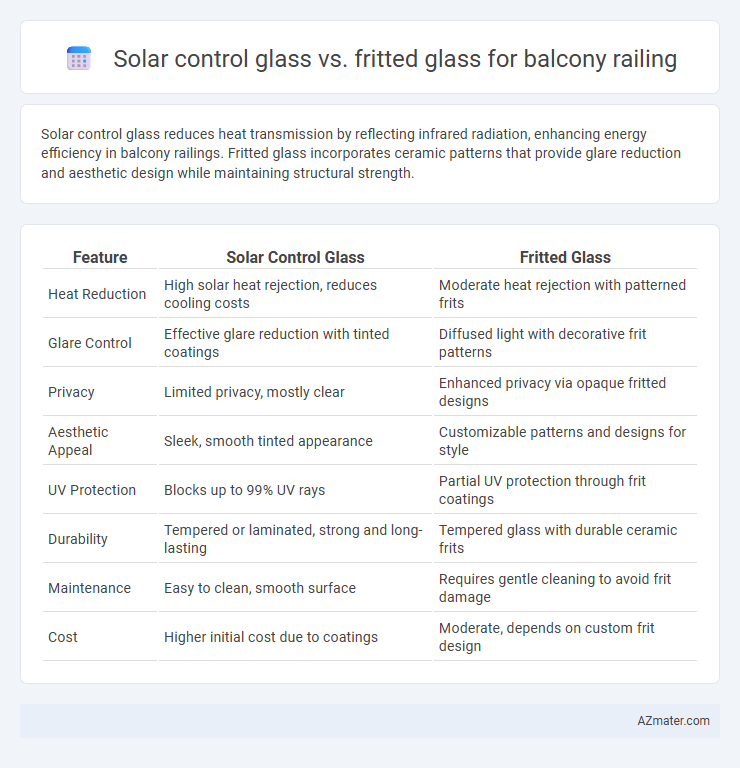Solar control glass reduces heat transmission by reflecting infrared radiation, enhancing energy efficiency in balcony railings. Fritted glass incorporates ceramic patterns that provide glare reduction and aesthetic design while maintaining structural strength.
Table of Comparison
| Feature | Solar Control Glass | Fritted Glass |
|---|---|---|
| Heat Reduction | High solar heat rejection, reduces cooling costs | Moderate heat rejection with patterned frits |
| Glare Control | Effective glare reduction with tinted coatings | Diffused light with decorative frit patterns |
| Privacy | Limited privacy, mostly clear | Enhanced privacy via opaque fritted designs |
| Aesthetic Appeal | Sleek, smooth tinted appearance | Customizable patterns and designs for style |
| UV Protection | Blocks up to 99% UV rays | Partial UV protection through frit coatings |
| Durability | Tempered or laminated, strong and long-lasting | Tempered glass with durable ceramic frits |
| Maintenance | Easy to clean, smooth surface | Requires gentle cleaning to avoid frit damage |
| Cost | Higher initial cost due to coatings | Moderate, depends on custom frit design |
Introduction to Balcony Railing Glazing Options
Balcony railing glazing options include solar control glass and fritted glass, each designed to enhance safety and comfort while providing aesthetic appeal. Solar control glass reduces heat gain and UV radiation, improving energy efficiency and occupant comfort in outdoor spaces. Fritted glass features ceramic patterns that offer glare reduction, privacy, and enhanced durability, making it a versatile choice for balcony railing applications.
What Is Solar Control Glass?
Solar control glass is designed with a special coating that reflects and absorbs solar radiation, reducing heat gain and glare while allowing natural light to pass through, making it ideal for balcony railings in sunny environments. It improves energy efficiency by minimizing the need for air conditioning and enhances outdoor comfort without compromising visibility. Compared to fritted glass, which has ceramic patterns to diffuse light and provide privacy, solar control glass prioritizes thermal regulation and clarity.
Understanding Fritted Glass Technology
Fritted glass for balcony railing incorporates ceramic frit patterns baked onto the glass surface, enhancing solar control performance by reducing glare and improving thermal insulation. This technology creates a durable, decorative layer that blocks harmful UV rays and minimizes heat transfer without compromising visibility. Compared to solar control glass, fritted glass offers customizable designs and superior resistance to fading and weathering, making it ideal for both aesthetic appeal and energy efficiency in outdoor applications.
Aesthetic Differences: Solar Control vs. Fritted Glass
Solar control glass offers a sleek, uniform appearance with a subtle tint that enhances modern balcony designs while reducing glare and heat transmission. Fritted glass features decorative ceramic patterns fused onto the surface, providing a textured or patterned aesthetic that adds visual interest and privacy without compromising transparency. Choosing between the two depends on whether a minimalist, smooth finish or a customizable, patterned look better complements the balcony's architectural style.
Energy Efficiency and Thermal Performance
Solar control glass significantly enhances energy efficiency for balcony railings by reducing solar heat gain and blocking harmful UV rays, which lowers indoor cooling costs. Fritted glass, with its ceramic patterns, offers moderate solar control and glare reduction but typically delivers lower thermal insulation compared to specialized solar control coatings. Choosing solar control glass optimizes thermal performance by maintaining consistent indoor temperatures and improving overall energy savings.
Light Transmission and Glare Reduction
Solar control glass offers high light transmission rates typically ranging from 40% to 70%, allowing ample natural light while significantly reducing glare through its specialized coatings that reflect infrared radiation. Fritted glass features ceramic patterns baked onto the surface, which diffuse incoming light to reduce glare effectively but generally lowers light transmission to around 30%-50%. Choosing between solar control and fritted glass for balcony railings involves balancing desired daylight levels and glare control, with solar control glass providing clearer views and fritted glass offering enhanced privacy and patterned aesthetics.
UV Protection and Safety Features
Solar control glass offers superior UV protection by blocking up to 99% of harmful ultraviolet rays, reducing sun damage and glare on balcony spaces. Fritted glass enhances safety through its ceramic frit patterns that increase surface durability and prevent glass shattering upon impact. Both glass types comply with international safety standards, but solar control glass prioritizes UV defense while fritted glass emphasizes structural strength and visual privacy.
Maintenance and Durability Comparison
Solar control glass for balcony railings offers enhanced durability with its ability to withstand UV exposure and minimize heat buildup, reducing stress on the glass over time. Maintenance of solar control glass is relatively low, requiring only regular cleaning to maintain clarity and performance without the need for specialized treatments. Fritted glass, while visually appealing due to its ceramic patterns, can accumulate dirt in the fritted areas, potentially increasing cleaning frequency, and may experience gradual fading or wear of the fritted design, affecting long-term durability.
Cost Considerations for Balcony Railings
Solar control glass generally incurs higher initial costs due to advanced coatings that reduce heat transmission and improve energy efficiency, making it a premium choice for balcony railings. Fritted glass tends to be more cost-effective, combining durability with decorative patterns that enhance privacy and reduce glare without significantly increasing expenses. Balancing budget constraints and performance needs is essential, as solar control glass offers long-term energy savings while fritted glass provides an affordable aesthetic solution.
Choosing the Right Glass for Your Balcony
Solar control glass for balcony railing enhances energy efficiency by reducing heat gain and blocking harmful UV rays while maintaining clear visibility and natural light. Fritted glass offers increased safety and privacy with its ceramic frit patterns that also reduce glare and solar heat but can slightly diminish transparency. Choosing the right glass depends on balancing energy performance, aesthetic preferences, and privacy needs to ensure a comfortable and stylish balcony environment.

Infographic: Solar control glass vs Fritted glass for Balcony railing
 azmater.com
azmater.com